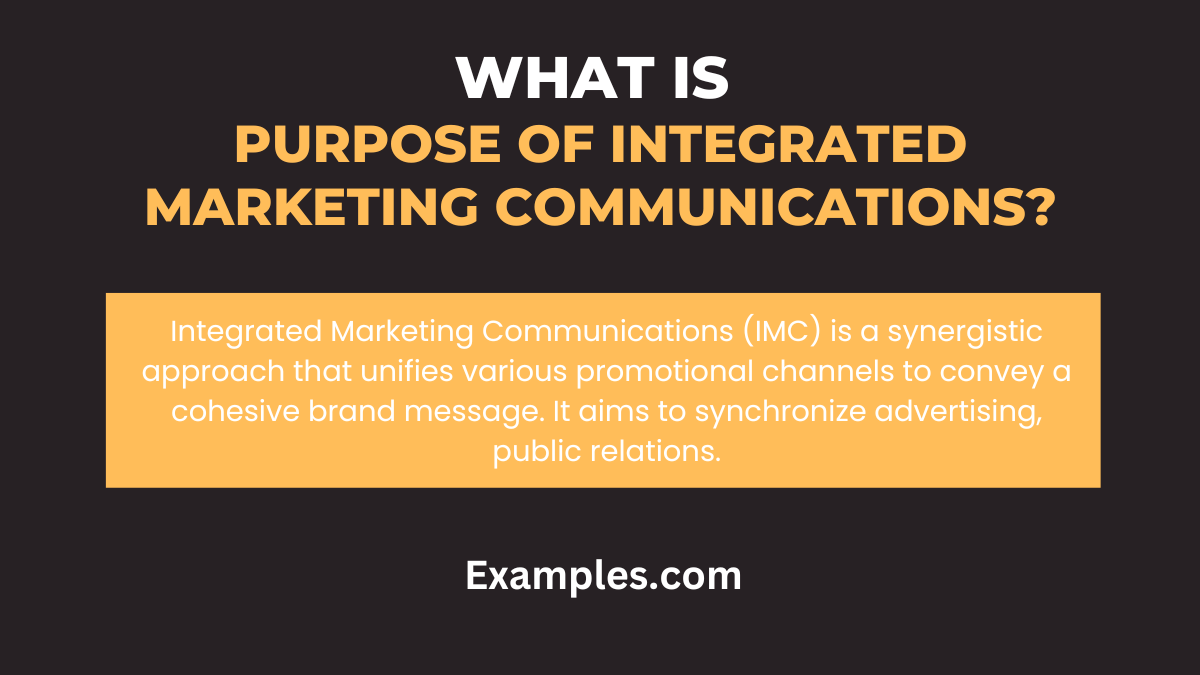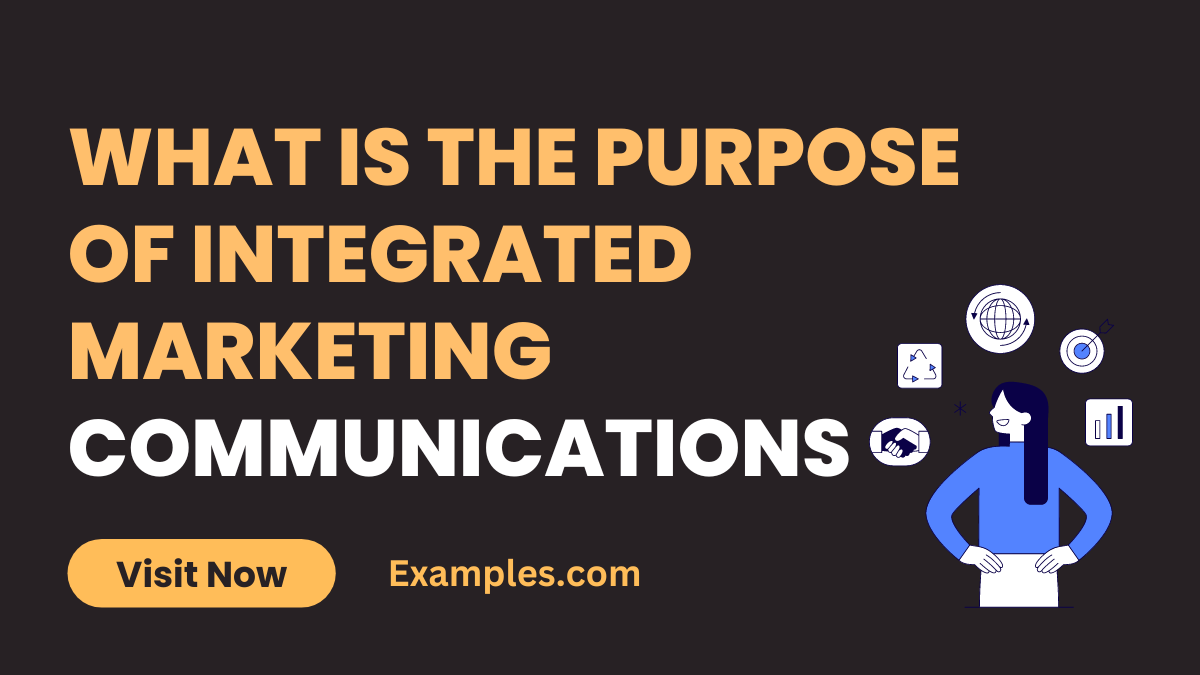What is the Purpose of Integrated Marketing Communications?
Unlock the strategic prowess of Integrated Marketing Communications (IMC)! This comprehensive guide illuminates the definition and intricacies, traces the origin and history, explores impactful examples, provides actionable tips, and unveils effective how-to strategies. Dive into the purpose of IMC, mastering a holistic approach to amplify brand messaging, strengthen customer connections, and elevate your marketing endeavors. Learn the art of integrating diverse channels for a harmonious and powerful marketing communication strategy.
What is the Purpose of Integrated Marketing Communications?

Integrated Marketing Communications (IMC) is a synergistic approach that unifies various promotional channels to convey a cohesive brand message. It aims to synchronize advertising, public relations, digital marketing, and other communication elements, fostering a seamless brand experience. IMC strives to enhance consistency, effectiveness, and consumer engagement by strategically blending diverse communication methods. This holistic strategy seeks to amplify brand visibility, build strong connections, and drive desired actions, contributing to a unified and impactful marketing campaign.
Purpose Of Integrated Marketing Communications Campaigns

Integrated Marketing Communications (IMC) campaigns serve to harmonize marketing efforts across multiple channels, ensuring a unified brand message. These campaigns integrate advertising, social media, PR, and more, aiming for consistency and optimal audience engagement.
- Apple’s “Shot on iPhone” Campaign: Apple utilized user-generated content, showcasing stunning images taken on iPhones. To improve, leverage user-generated content, engaging customers in your brand narrative.
- Coca-Cola’s “Share a Coke” Campaign: Coca-Cola personalized bottles with names, sparking a sense of ownership. To enhance, focus on personalized experiences to foster emotional connections.
- Airbnb’s “Live There” Campaign: Airbnb crafted a campaign focusing on experiencing destinations as a local. To refine, emphasize unique experiences for audience connection.
- Always’ “Like a Girl” Campaign: Always challenged gender stereotypes, empowering girls. To evolve, align campaigns with social issues to resonate with diverse audiences.
- Nike’s “Dream Crazy” Campaign: Nike encouraged dream pursuit, leveraging inspirational stories. To progress, use storytelling to engage and motivate your audience.
Purpose of Integrated Marketing Communication for Brand Building
Integrated Marketing Communication (IMC) plays a pivotal role in brand building, orchestrating a unified brand narrative across diverse channels. It ensures consistent messaging, imagery, and positioning to fortify brand identity. Leveraging IMC for brand building involves aligning marketing efforts with brand values, utilizing various touchpoints cohesively. For instance, Nike excels by harmonizing campaigns across media, fostering a robust brand image.
- Nike’s Just Do It Campaign: Nike’s IMC strategy exemplifies brand building through consistent messaging, emphasizing empowerment and motivation.How to Improve: Maintain a clear brand voice, align marketing content with brand values, and prioritize consistency across all platforms.
- Apple’s Seamless Product Launches: Apple’s IMC success lies in synchronized product launches, creating anticipation and reinforcing a premium brand image.How to Improve: Integrate product launches with storytelling, ensuring a unified narrative that resonates with the target audience.
- Coca-Cola’s Timeless Branding: Coca-Cola’s iconic branding showcases the longevity achieved through IMC, emphasizing a consistent brand message over decades.How to Improve: Continuously assess and adapt brand messaging to stay relevant, addressing changing consumer preferences.
- Starbucks’ Experience-Oriented Marketing: Starbucks employs IMC to create a cohesive brand experience, blending advertising, store design, and customer engagement.How to Improve: Prioritize customer experience, intertwining physical and digital interactions to enhance brand perception.
- Amazon’s Holistic Brand Presence: Amazon’s IMC strategy emphasizes reliability, with a consistent brand promise visible in advertising, packaging, and customer service.How to Improve: Focus on delivering a seamless experience, ensuring that every customer touchpoint aligns with the brand’s intended image.
Objectives of Integrated Marketing Communications
Integrated Marketing Communications (IMC) serves multiple strategic objectives to fortify a brand’s communication efforts. These objectives synergize diverse marketing channels for comprehensive impact:
- Consistency in Messaging: IMC aims to ensure a consistent brand message across all communication channels, fostering a unified and recognizable identity.
- Enhanced Brand Visibility: The primary goal is to boost brand visibility by strategically integrating promotional efforts, creating a more potent and memorable market presence.
- Customer Engagement: IMC seeks to engage customers effectively through a seamless blend of advertising, public relations, and digital marketing, fostering meaningful interactions.
- Building Brand Equity: By aligning diverse communication elements, IMC contributes to the development of strong brand equity, enhancing the perceived value and credibility of the brand.
- Optimized Marketing Budget: Efficient coordination of marketing channels under IMC ensures optimal resource allocation, preventing redundancy and maximizing the impact of each element.
- Effective Communication Strategy: IMC aims to refine communication strategies, aligning them with organizational goals and market trends for heightened effectiveness.
- Market Responsiveness: The strategy emphasizes staying responsive to market changes, allowing quick adjustments in messaging and tactics based on real-time feedback and evolving trends.
- Consumer Trust and Loyalty: By presenting a cohesive and reliable image, IMC seeks to build trust and foster loyalty among consumers, driving long-term relationships.
- Competitive Advantage: Through an integrated approach, brands can gain a competitive edge by presenting a more cohesive and impactful front compared to fragmented competitors.
- Measurable Results: IMC establishes metrics to evaluate the success of various communication elements, enabling data-driven decisions and continuous improvement.
What Are The Benefits of Integrated Marketing Communications?
Integrated Marketing Communications (IMC) offers a multitude of advantages for businesses striving to amplify their marketing efforts. Here’s a comprehensive guide to the key benefits:
- Consistent Brand Messaging: IMC ensures uniformity in brand messages across diverse channels, fostering a cohesive identity and enhancing brand recall.
- Enhanced Customer Engagement: By integrating various communication platforms, businesses can create interactive and engaging experiences, strengthening connections with their audience.
- Cost Efficiency: IMC streamlines marketing efforts, eliminating redundancies and optimizing resource allocation, leading to cost savings.
- Improved Marketing ROI: The cohesive approach of IMC often results in more impactful campaigns, ultimately maximizing return on investment.
- Holistic Customer Understanding: By integrating data from various channels, businesses gain a comprehensive understanding of customer behavior and preferences.
- Adaptability and Agility: IMC allows businesses to adapt quickly to market changes and emerging trends, ensuring campaigns remain relevant and effective.
- Competitive Edge: A well-executed IMC strategy provides a competitive advantage by delivering a unified and memorable brand presence in the market.
- Increased Marketing Effectiveness: The synergistic combination of marketing elements amplifies the overall impact, making campaigns more effective in achieving business objectives.
- Customer Trust and Loyalty: Consistent messaging and experiences foster trust, leading to long-term customer loyalty and advocacy.
- Measurable Performance: IMC facilitates the measurement of campaign performance across multiple channels, allowing businesses to refine strategies based on data-driven insights.
In conclusion, Integrated Marketing Communications (IMC) is a dynamic strategy that harmonizes diverse promotional channels to achieve unified and impactful communication. This comprehensive guide explored IMC’s purpose, benefits, and key components, offering insights and examples to empower businesses in crafting effective and cohesive marketing campaigns, ensuring lasting connections with their audience in today’s dynamic marketplace.



